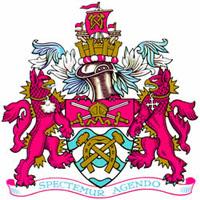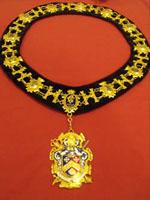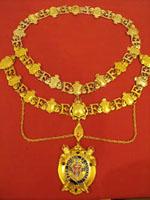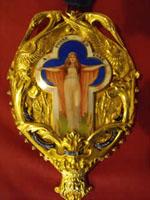Coat of Arms of London Borough of Hammersmith & Fulham

The coat of arms was granted on 1 March 1965, incorporating devices from the coats of arms of the former Metropolitan Boroughs of Fulham and Hammersmith.
The main motif of two gold hammers inter-laced with a gold horseshoe is an indication of the borough's name. The blue and white wavy bars on the shield represent the River Thames. Above are the crossed swords and gold mitre of the Bishops of London, lords of the manor of Fulham for almost 11 centuries.
The turreted crest on the helmet represents civic authority. Above this is a black ship denoting the presence of the Danes in Fulham in 879AD.
Two griffins, mythical creatures of strength and vigilance, symbolise the merging of the boroughs. They sprout rays of progress and enlightenment. Round their necks hang the symbols of two men important to the development of Hammersmith; the scallop shell of George Pring, a supporter of the first Hammersmith Bridge, and the crosslet of Edward Latymer, who left property for the welfare and education of the poor.
The motto Spectemur Agendo was adopted in 1969 from the original motto of the Metropolitan Borough of Hammersmith. It can be translated as 'Let us be judged by our actions'.
The mace

The silver gilt mace was presented to Hammersmith Borough Council in 1900 by William Joseph Smith, a member of the former Vestry; an inscription around the base records this fact.
The mace was made by the Goldsmith's and Silversmith's Company. It is 3ft 7ins long and weighs 100 ounces. The upper portion is surmounted by the Imperial crown, with the royal arms and a Maltese cross above. Around the upper portion are the coats of arms of the Metropolitan Borough of Hammersmith, the Episcopal See of London, the last Chairman of Hammersmith Vestry, and George Pring, promoter of the first Hammersmith Bridge. These are interspersed with clusters of roses, shamrocks and thistles. The stem is decorated with mulberry leaves and Tudor roses. The letter H adorns the base.
Mayoral chain and badge - Hammersmith

The Hammersmith Mayoral chain and badge were provided by public subscription and presented to Hammersmith Metropolitan Borough Council on the subscribers' behalf by W J Bull, MP (later Sir William Bull). It was made by the Goldsmith's and Silversmith's Company and the artist and borough councillor, Sir William Blake Richmond, was consulted over the design.
The chain, which is made of 18 carat gold, consists of alternate linking letter Hs, with crossed hammers, and ornamental shields for engraving the names of successive Mayors. The badge, consisting of a gold and enamelled replica of the coat of arms of Hammersmith Metropolitan Borough, is suspended from a centre link bearing the initials of the first Mayor, Thomas Chamberlen, and the date 1900.
Mayoral chain and badge – Fulham

The second Mayoral badge of the Metropolitan Borough of Fulham was the gift of the 16th Mayor of Fulham, Fred Holgate Barber, in 1928. Made of 18 carat gold it shows the new coat of arms, granted to Fulham on 12 October 1927. This includes the crossed swords and golden mitre of the Bishops of London, the wavy bars of the river and the sailing ship of the Danes. The motto is 'Pro civibus et civitate' meaning 'For citizens and state'.
The chain is composed of alternate shields and the letter F connected by a wave link pattern chain. The shields have a crane on either side, and are surmounted by a crown. The centre link is surmounted by an imperial crown.
Deputy Mayor's badge

The Deputy Mayor wears the original mayoral badge of the Metropolitan Borough of Fulham. Composed of 18 carat gold, it was given, on 8 January 1902, by Fulham's second mayor, Timothy Davies. It was designed by Ernest Avern of Fulham, and manufactured by the Goldsmiths and Silversmiths Company of Regent Street, W1.
In the centre the enamelled figure of a maiden rises out of the mire, symbolically representing the raising up of the borough; above are depicted two cranes or fowls, and below appears the head of Father Thames.
The motto 'A posse ad esse' is translated as 'From possibility to actuality'.